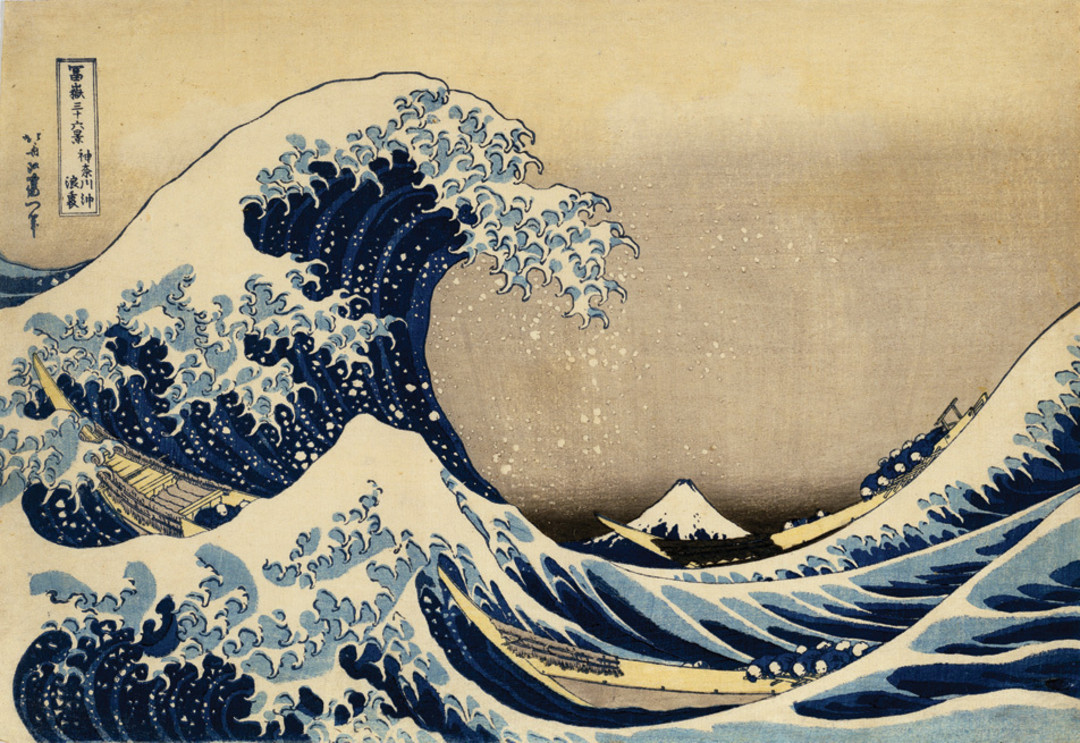10 Must-See Masterpieces
1. How My Mother’s Embroidered Apron Unfolds in My Life
1944/Arshile Gorky
SEATTLE ART MUSEUM
After escaping Turkish oppression in his native Armenia, painter Arshile Gorky (1905–48) moved to New York. He may be seen as the bridge in American art between the likes of Europeans Miró, Cézanne, and Picasso, and the New York movement of abstract expressionism, in the form of Jackson Pollock and Willem de Kooning. He even shared a studio for a time with de Kooning. But sadly, Gorky’s life was punctuated by tragedy—including a devastating fire that destroyed his studio and much of his work—and ended with his suicide.
Knowing the artist’s troubled history adds a new layer to How My Mother’s Embroidered Apron Unfolds in My Life. The highly specific title of this piece is characteristic of Gorky’s work. It gives a sense of what was on his mind when he was painting and urges us to look for forms and narrative within the abstract wash of colors.
{page break}

2. Abraham Lincoln
1864 / Mathew B. Brady
HENRY ART GALLERY, MONSEN COLLECTION
Mathew Brady (1823–96) is generally considered the first photojournalist in America—a trailblazer who envisioned using the relatively new medium to document events for historical record. To this end, he spent all of his time and extensive personal fortune photographing the American Civil War. His grim depiction of corpses on the battlefield of Antietam introduced the reality of war to many Americans, but his 30-some photo portraits of President Abraham Lincoln are his legacy.
Before the 1830s, the task of documenting individuals and events fell primarily to painters. Nineteenth-century art academies taught a naturalistic (and some might say melodramatic) style in which realism was favored. But with photography in the picture, painters no longer needed to cleave to realism.
Photography liberated painting, inviting artists to ask, “What can paint achieve that other mediums can’t?” The answer: impressionism, cubism, minimalism, and abstract expressionism, leaving the task of documentation to Brady and the new generation of photographers.
{page break}

Image: Seattle Art Museum
3. The Great Wave
1832 / Katsushika Hokusai
SEATTLE ASIAN ART MUSEUM
In the Well of the Great Wave off Kanagawa, to use its full title, is probably the single best-known work of Japanese art. This woodblock print by artist Katsushika Hokusai (1760–1849) is the first in a series of prints titled Thirty-six Views of Mount Fuji, originally created to satisfy Hokusai’s fascination with the peak.
Hokusai brings astonishing skill and movement to this relatively straightforward medium. He captures a frozen moment of high drama: A monstrous wave is poised to crash on the slender fishing boats bobbing in the sea. In the far distance, the mighty snow-strewn Fuji resembles a white-capped wave. It invokes the sublime, reminding us of our relative helplessness as humans against the thunderous power of nature.
This is also the most famous example of the ukiyo-e Japanese print technique from the Edo Period (1615–1868). Ukiyo-e, translated as “pictures of the floating world,” were revolutionary in their depiction of the lower classes of Japanese society, who were newly flexing their cultural muscles and creating their own art, literature, and theater.
{page break}

Image: Seattle Art Museum
4. Wake
2004 / Richard Serra
OLYMPIC SCULPTURE PARK
While studying at Yale, Richard Serra (born 1939) earned pocket money working in a steel mill, and the lessons learned there proved vital to his most famous sculptural medium: weathered steel.
Serra is known as a “process artist,” meaning that the act of creating an artwork, from inception to creation to display, is at least as important as the end product. He doesn’t actually create the artwork—he designs it and supervises its construction at industrial steel mills.
{page break}

5. Sin
After 1906 / Franz von Stuck
FRYE ART MUSEUM
A seductive, scantily clad woman stares out at you, an enormous boa constrictor draped across her shoulders. Though there is a clear and intended eroticism to the painting, it’s primarily an allegorical work by German symbolist painter Franz von Stuck (1863–1928). Allegorical paintings were popular in the sixteenth and seventeenth centuries; there was even a handbook by Italian printer Cesare Ripa mapping out models for various allegories: sin, loyalty, penitence, jealousy. In this case, the female nude is meant to represent an abstract concept.
What’s interesting is the difference between this twentieth-century Sin and an earlier, more subdued version painted in 1893 (The Sin), which won Stuck his first critical acclaim. While shadows obscure both the snake and the woman’s face in the older work, the second Sin, with its green-tinged serpentine femme fatale, incorporates a more fantastical element.
{page break}

Image: Seattle Art Museum
6. Crows
c. 1625–50 /
Anonymous
Japanese Artist
SEATTLE ASIAN ART MUSEUM
Two six-panel screens were painted in gold and ink on paper by an unknown artist in seventeenth-century Japan (only the left screen is depicted here). Nearly 100 crows, shown in silhouette, swarm the amorphous gilded background. The simplicity is arresting—it is almost abstract—but the gilding and multiple panels recall both Orthodox Christian icons and polyptych altarpieces.
Painted screens rose in popularity in the sixteenth and seventeenth centuries, particularly those depicting pastoral or genre scenes—the natural world or snapshots of daily life, sometimes with subtle references to literature. These were meant to be enjoyed and admired in private homes. In 2007, Seattle Art Museum held a symposium entitled “Masterpieces of Japanese Painting” to celebrate the conservation of this and other masterworks from its collection. Crows has never looked so fresh and beautiful.
{page break}

Image: Seattle Art Museum
7. Some/One
2001 / Do-Ho Suh
SEATTLE ART MUSEUM
Korean sculptor Do-Ho Suh (born 1962) creates large-scale installations, works that fill galleries and must be seen in person for full impact. This piece in particular changes dramatically as you approach it. From a distance Some/One looks like the tail of a glimmering, wet whale rising out of the floor. From another angle, the skirt of the installation resembles a Korean costume, a colossal robe or chain-mail armor spread out over the floor and rising at the center, as if worn by an invisible man.
Now move closer. The chain mail reveals itself to be 40,000 steel dog tags, the sort issued to U.S. Army soldiers. Knowing that this solid, armorlike sculpture is made up of thousands of personal items—each representing a life story—is an allegory of the army itself. From a distance, the collective term “army” is impersonal, powerful, and yet an army is no more than the sum of its component parts—human beings, each one vulnerable.
{page break}

8. Parc Monceau
1897 / Frederick
Childe Hassam
FRYE ART MUSEUM
Among the gems of the Frye, this painting by the leading American impressionist stands out. Boston native Frederick Childe Hassam (1859–1935) was incredibly prolific, producing more than 3,000 works in his lifetime. He also connected American painting to the impressionists in Paris.
The impressionists began as a group of artists who objected to the elitist, naturalistic leanings of academic painting in Paris in the late nineteenth century. The annual Paris Salon determined mainstream tastes and paintings selected for display; it could make an artist’s career. But salon judges favored melodramatic realistic paintings—tubercular mothers and their shivering offspring, or generals leading troops through a snowstorm. In 1863 the salon rejected thousands of submissions, far more than any other year. The rejected artists established the Salon des Refusés to showcase their work. The impressionists, Monet most famous among them, began to show in this alternative salon. Hassam was inspired by the paintings he saw on a trip to Europe in 1886. He loved the impressionists’ use of dabs of paint to illustrate the play of light, and in turn painted his own pictures of bourgeois Americans at leisure.
{page break}

Image: Seattle Art Museum
9. Episodes from the Aeneid
c. 1470 / Paolo Uccello
SEATTLE ART MUSEUM
Florentine painter Paolo Uccello (1397–1475) was fascinated by the new Renaissance concept of mathematically reproducing perspective—the illusion that a two-dimensional painting showed a three-dimensional view. He was so singularly obsessed, fellow artists joked that he didn’t bother to paint anything else accurately.
Uccello was commissioned to paint scenes from Virgil’s first-century Latin epic poem The Aeneid, about the Trojan warrior Aeneas who fled Troy and endured a treacherous journey to Italy, where he founded Rome. But Uccello took the basic theme of The Aeneid only as a point of departure, and painted a more contemporary battle scene instead, a work in which galleons, fortified walls, knights, and some costumes are of fifteenth-century Italy. It seems the subject matter was simply an excuse for Uccello to do what he loved best: paint vibrantly colored large-scale scenes in which he toyed with perspective, lines, and geometry, often sacrificing naturalism, well-formed bodies, and depth in the process.
{page break}

Image: Seattle Art Museum
10. Posthumous Portrait Head of Emperor Claudius
c. 60 AD / Anonymous
Roman Sculptor
SEATTLE ART MUSEUM
Roman artists typically accompanied armies to settle and decorate newly conquered territories. As they crafted triumphal statuary, their goal was to create lifelike human figures out of stone but to idealize them as the epitome of beauty, balance, form, and nobility. Bodies took the shape of godlike warriors—handsome, athletic Adonises—while faces maintained a certain likeness (minus the warts). Statues of emperors served as propaganda, vaunting the statesmen’s triumphs and providing the empire’s subjects in far-flung locales a glimpse of their emperor.
Such is the case in this posthumous portrait head of the Emperor Claudius, who reigned between 41 and 54 AD. It was almost certainly the head of a full-body cult statue of Claudius who, as was tradition, had been deified upon his death, joining the pantheon of Roman gods. The statue might have been intended for public display or for worship in one of the temples erected to honor Claudius.





